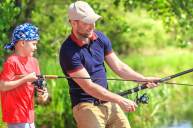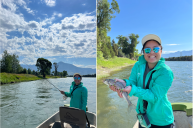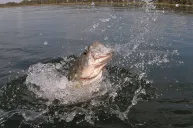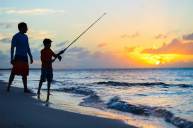The idea of fishing is relatively simple. You cast a line out into the water, wait for a bite, and then reel in a fish. Easy peasy. But the reality is it's not that simple, especially if you've never done it before. While you don't need a ton of skill or training to start, you do need some information, a few pieces of gear, and a little bit of instruction on how to start fishing.
While we can't guarantee that you'll catch anything on your first time out, we can help you maximize your chances. And that's the point of this guide. We'll cover finding a fishing spot, essential gear, setting up your fishing rig, safety and etiquette, and basic fishing skills like casting, reeling, and handling a fish.
Research Your Fishing Spot
On your journey to become an angler, one of the first things you need to do is find a fishing spot, or at least, narrow down a selection of locations. While the type of fish living or stocked in a body of water might dictate things like bait and gear, it'll also determine whether or not you need a fishing license. Although you won't need a license if you're fishing on private property, most places require one for fishing in public waters. However, the rules vary by state and locality, which is why finding a fishing spot should be one of the first things you do. You can do this by checking with a state's wildlife agency and even local fishing groups.
Essential Fishing Gear
Most sporting goods stores sell fishing rod and reel combos that come with pretty much everything you'll need to start fishing, but it's important to know what these items are, what they're for, and how to use them. These items include: a fishing rod and reel, fishing line, hooks, sinkers, and bobbers.

Credit: Utah Department of Natural Resources
Rod and Reel
When it comes to fishing, rods and reels go hand in hand. Literally. While there are an assortment of rods and reels to consider, experts recommend using one combination in particular if you've never fished before - a medium-powered fast-action spincast. And if you've never fished before, that probably means nothing to you, which is why we'll break it down.
Rod Types
When you're shopping for a fishing rod, there are four types to consider. These include a cane pole, which is essentially a stick with a fishing line tied to it; spincasting and baitcasting rods, which are equipped with a handle and guides; a spinning rod, which has a handle and guides that decrease in size; and a fly rod, which is really flexible.
However, rods are also designed with certain characteristics, which is where the other terminology comes into play. These include length, action, and power. For length, the takeaway is that a longer rod - something like seven feet is manageable for beginners - will help you cast with greater distance and control.
Next, the "action" of a rod refers to how much it bends. The three types include fast, medium, and slow. A "fast" action rod is less flexible so it's more responsive to subtle movements, which you might want if you're trying to get a fish's attention, whereas a slow action rod has greater flexibility, which is helpful if you play tug and war with a big fish.
Lastly, power will be listed as light, medium, or heavy. Light rods are for lightweight lures and heavy rods are for heavyweight lures. Make sense?
Reel Types
As for fishing reels, there are two kinds: spincast and spinning. Experts recommend a spincast reel for beginners because its controls consist of simply a button and a handle. The way it works is you press and hold the button and then let it go as you cast out the line. Typically, the only other thing you can control is the speed in which the line moves, which you can tighten or loosen.
The other type of reel is called a spinning reel. It's an open-face design, so the spool of fishing line is exposed. While it allows for farther casting, it's a less intuitive design.

Credit: Take Me Fishing/Facebook
Fishing Line
When it comes to fishing line, pretty much every expert will recommend monofilament line. It comes in a variety of weights, but the main thing to know is that heavier weight fishing line is thicker so it can withstand the pull of larger fish.
Hooks
To the untrained eye, most fishing hooks look the same in that they're all curved pieces of metal with pointy ends, but there are subtle differences. Nonetheless, experts say a circle hook is the best for beginners. The reason is it's a general use hook that's easy to remove from a fish's mouth. The others are designed for specific types of fishing.
Sinkers
A sinker, or fishing weight, does two things. First, it helps you cast your line out farther and second, it weighs down bait so it sinks deeper in the water and closer to the fish. Sinkers vary in size and shape - some lay flat and others bounce off rocks - but most anglers recommend using split shot sinkers - metal balls that you clamp onto the fishing line — because it works for both live and artificial bait.
Bobbers
Experts say a fishing bobber is ideal for beginners, especially if you're fishing in a lake, pond, or any body with calm waters. What it does is float in the water until something pulls it down (like a fish) at which point you know to reel in the line.
Tackle Box
A tackle box is a helpful piece of equipment because you can use it to store tools as well as extra gear like pliers, nail clippers, measuring tape, permits, guides, first aid kit, bug spray, sun block, etcetera.
Bait vs Lure
Whether you use bait or a lure depends on your preference and the type of fish you're trying to catch. When anglers say bait, they mean living things like worms, grasshoppers, crickets, minnows, and anything else that fish will eat. But it can also mean food like bread or cheese. Again, anything the fish will eat. You can figure what's best to use through research or asking locals.
A lure is artificial bait designed to look like something a fish will eat. They'll often look like another fish or animal and are typically designed to look alive in the water. In general, experts recommend that you use bright colored lures in murky water and natural colored lures in clear water.
Setting Up Your Fishing Rig
Knot Tying
When you're setting up your fishing rig, there are tons of knots you could use, but you really only need to know two. One for attaching a line to your hook and the other for attaching line to your reel. Some of the most common recommended knots to learn include the Palomar knot, an improved clinch knot, and an arbor knot. The first two are for the hook and the last one is for the reel.

A clinch knot. Credit: USFW
Sinkers and Bobber
After you have your hook attached to your line, you can add your sinkers and bobber. Most anglers recommend attaching your sinker about four fingers (your fingers) above the hook. If you're using split shot, you'll need a pair of pliers to fasten it to the line.
And then, attach the bobber about a foot above the sinker and then make adjustments based on the depth of the water. Attaching a bobber is straightforward as a basic design has attachment points on the top and bottom of the floating device.
Baiting Your Hook
When you're baiting the hook, the most important thing to remember is to make sure that the bait is securely on the hook. You don't want it coming off as you cast. Additionally, if you're using live bait, you'll want it hooked so it moves in the water and gets a fish's attention.
Safety and Etiquette
While most fishing safety and etiquette rules are commonsense, we still prioritize it above the actual act of fishing. Even though fishing is a fairly safe sport, people are flinging around small, sharp hooks that can really hurt someone. With that said, you generally want to keep one rod's length between you and another angler and always make sure no one is behind you or to the sides of you when you cast. You should also exercise situational awareness by avoiding tall grass, wearing appropriate clothing and sunblock, and wearing a life jacket (if you're on a boat).
Casting & Reeling
Casting Your Line
With your fishing rod, allow a little bit of line to dangle from the tip of the pole (a couple inches past your bobber) and face the direction you want to cast your line. With a firm grip on the pole, press and hold the button on the reel, swing the slack line back, and then whip it forward while simultaneously releasing the reel. Once the bait is out in the water, press the button on the reel to lock it and then wait. While there's no set amount of time you need to wait, you should exercise patience. Some recommend waiting 15 or 20 minutes before recasting unless you get a bite.
Reeling in a Fish
There are a few indicators that suggest a fish has taken the bait. The first is you might see your bobber go under water and second, you'll feel a sudden tension on your line, it'll stay taut, and it might even move around. If that's the case, a fish is probably biting, so you'll want to set the hook by pulling back with the rod. Next, you'll want to reel in the fish unless it's pulling. If it is pulling, give the fish some slack and wait for it to stop, and then start reeling it in. Remember: slow and steady wins the race.
Handling the Fish
There are several reasons you should be cautious when handling a fish. First off, not all species of fish are the same. Some have teeth or sharp fins. But also, you don't want to damage a fish you plan on eating it and you don't want to injure a fish you plan on releasing it. No matter what your plan is, you should aim to do the least amount of damage possible. You can do that by following a few rules:
- Wet your hands before touching it to help reduce the loss of a fish's protective mucus.
- Handle it gently by supporting its weight, keeping it horizontal, and not squeezing it.
- Avoid touching its eyes and gills because both are delicate organs and needed for survival.
- And if possible, keep its gills submerged in water, so it has an easier time recovering.
How to De-Hook a Fish
Whether you plan on keeping the fish or releasing it, you'll need to de-hook it. The easiest way is to grab the base of the hook with your fingers and pull it out of the fish's mouth. If a fish's mouth is too small or it has teeth, you'll want to use a tool called a disgorger. You guide the tool along the fishing line until you reach the hook, then you just push the hook out, and remove the disgorger from its mouth.
Let's Go Fishing
If you take anything from this article about how to start fishing, it should be this: don't like something like not know what you're doing stop you from fishing. If you get yourself some basic gear, follow the rules, and be considerate of others, you'll have a great fishing trip (whether or not you catch anything).
Sources
For this guide, we compiled information and suggestions from a variety of sources, including website's like Take Me Fishing, multiple wildlife agencies (in particular, South Carolina, New York, Utah, the National Park Service, and the U.S. Fish & Wildlife Service), and experts, which we linked in the body of the article.




